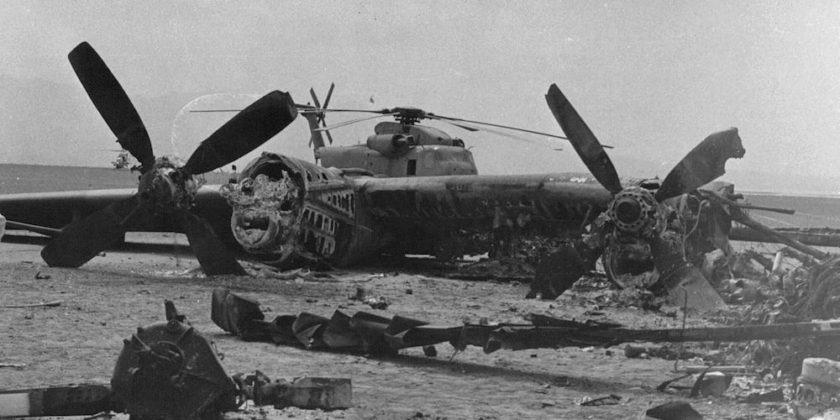A weakened leader in a powerful country can be a recipe for danger. Donald Trump’s encroaching legal troubles might prove just the time for a seriously big international crisis, even a bit of a war. The obvious choice is Iran, and Trump may well have been heading that way even before his latest problems with Michael Cohen, Paul Manafort and potentially special investigator Robert Mueller.
Trump may be confident of holding firm to his support base and thus ensuring the loyalty of Republican candidates in the mid-term Congressional elections. But as pressure grows on him, a conflict with Iran – encouraged by Israel’s prime minister Binyamin Netanyahu, who faces domestic pressures of his own – could look even more attractive.
Amid rising tensions, European capitals worry that the nuclear treaty with Iran will not survive. Their anxieties go in both directions: looking to wise counsels in Washington able to dissuade Trump and his hardline advisors from a dangerous path, yet also concerned that powerful religious and military leaders in Iran – including the Iranian Revolutionary Guard Corps – might welcome conflict with the United States. To many Europeans, and moderate voices elsewhere (among them the more cautious Iranian president, Hassan Rouhani), it may appear that irrational tendencies are driving the US and Iran towards military catastrophe (see “Iran, and a diplomacy deficit“, 1 September 2017).
At this perilous moment it might help for the historical aspect of this potential clash to be recognised, particularly by European states which share the habit of dwelling on the past. In the UK’s search for lost empire, for example, key events of fairly recent vintage, the Dunkirk episode and the aerial Battle of Britain in 1940-41, are endlessly revisited as signposts of greatness and demonstrations of national character.
That tendency to look beyond the immediate context ought to give British commentators the imagination to grasp the importance of past events in Iran. A prime instance is the downfall of Iran’s prime minister, Mohammad Mossadegh, in 1953, orchestrated by Washington and London – a coup which climaxed sixty-five years ago this week (see “The Iran complex: why history matters“, 26 January 2012).
It was done in retaliation for Iranian attempts to take control of their own oil industry, then held by western states, principally Britain. Its success ushered in the quarter-century reign of the autocratic Shah, whose regime Washington viewed as an essential prop in the regional alliance constraining Soviet ambitions at the height of the cold war.
The Shah’s overthrow in the revolution of 1978-79 led in turn to rule by conservative theocrats. Since then a young and well-educated population with plenty of interest in western culture has emerged. But what happened in 1953 is still deeply embedded in Iranians’ worldview. In turn, however, it relates to a broader memory of a country subject to intense rivalry between Russia and Britain in the nineteenth century – and beyond that to millennia of culture with far older foundations than Russia or Britain, to say nothing of that Johnny-come-lately, the United States.
A fatal divergence
But if the fate of Mossadegh remains lodged in Iranian political memory, it is equally important to recognise the equivalent on the American side, which relates directly to the fall of the Shah in 1979. Towards the end of that year, on 4 November, Iranian students overran the US embassy in Tehran and undetained sixty-eight staff and family members. Several were allowed to leave, but fifty-two were held hostage until January 1981 – and released as the newly elected president, Ronald Reagan, gave his inaugural address.
The seizure of the embassy, a prelude to what turned out to be a 444-day crisis, hugely magnified inter-state tensions from the US point of view. Not only had they lost a key ally in the region, but they now seemed powerless in face of the new regime’s diplomatic violation. The stand-off hugely weakened the incumbent president, Jimmy Carter, and he was further damaged by the embarrassing failure of an attempt by special forces to rescue the hostages.

This was Operation Eagle Claw, launched on 25 April 1980, during the early months of Carter’s re-election campaign. The Tehran hostages were ever present in the contest and US impotence in relation to them was a key factor in Carter’s defeat.
More broadly, the whole episode had a lasting effect within the United States in shaping attitudes towards Iran – including among US diplomats, and indeed the whole state department. A particularly sharp resentment of Iran in the American body politic continues to this day.
Trump, being concerned primarily with himself, may be largely unaware of these details of the Iran-US relationship. But some of his advisors, such as national-security hawk John Bolton, are steeped in it. They look forward to the day when the United States can neutralise Iran and regain influence and possibly even control in Tehran, thus finally lancing the boil of the hostage crisis (see “Target Tehran“, 10 May 2018).
That may be a pipedream, but it has had further salience since the disastrous invasion of Iraq in 2003, which led to heightened Iranian influence in the Middle East. This change in the regional balance of power – the very reverse of what US planners confidently expected – is now of supreme concern to Israel and Saudi Arabia.
Many independent analysts argue that any kind of war with Iran could be another unmitigated disaster and should in no way be countenanced. But what makes sense may count for little when history, as experienced by both sides in a dispute, points in opposite directions. Any assessment of the risk of war needs to take this vital factor into account.
Cover photo: Iranian students climb over the wall of the U.S. embassy in Tehran during the Iranian Revolution, 4th November 1979. The students went on to seize the embassy staff, and hold 52 of them as hostages for 444 days. (Photo by AFP/Getty Images)






